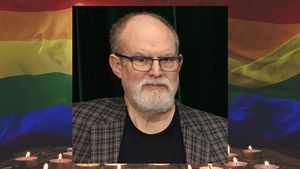The future the gays want is coming — at least according to a newly released poll.
The proportion of U.S. adults identifying as LGBTQ+ has continued to increase, reaching a new high of 7.6 percent in the latest Gallup poll, released Wednesday morning.
That’s up from 7.2 percent in the poll that came out a year ago, from 5.6 percent four years ago, and from 3.5 percent in 2012, Gallup’s first year of measuring sexual orientation and transgender identity.
Gallup seeks out this information because “it’s important to document that and how it’s changing,” Gallup’s Jeffrey M. Jones tells The Advocate. Jones is senior editor for Gallup and author of an analysis of the latest findings.
The numbers are drawn from phone surveys conducted by Gallup in 2023, reaching 12,000 American adults. The polling organization asked respondents whether they identify as heterosexual, lesbian, gay, bisexual, transgender, or something else. Overall, 85.6 percent identified as straight or heterosexual, 7.6 percent chose one or more identities within the LGBTQ+ community, and 6.8 percent declined to say.
As in previous years, the growth was driven by younger generations. “Overall, each younger generation is about twice as likely as the generation that preceded it to identify as LGBTQ+,” Gallup’s analysis of the data states. In 2023, 22.3 percent of Generation Z respondents (born 1997 and later) claimed an LGBTQ+ identity, and 9.8 percent of Millennials (born 1981-1996) did. The figures were 4.5 percent for Generation X (born 1965-1980). 2.3 percent for Baby Boomers (born 1946-1964), and 1.1 percent for the Silent Generation (born 1945 and earlier).
The greater LGBTQ+ representation among younger people could be due to more acceptance of LGBTQ+ identity and therefore greater willingness to come out, or it could be attributable to other factors; this is outside the scope of Gallup’s research, Jones says.
The largest proportion of LGBTQ+ respondents identified as bisexual, with 4.4 percent of the overall sample and 57.3 percent of LGBTQ+ adults saying they are bi. “Bisexuality is the most common LGBTQ+ status among Generation Z, millennials and Generation X,” Gallup’s analysis notes. “Fifteen percent of all Generation Z adults — representing more than two-thirds of those with an LGBTQ+ identification — are bisexual. In the older generations, LGBTQ+ individuals are more likely, or equally as likely, to say they are gay or lesbian than bisexual.”
Women were nearly twice as likely as men to identify as LGBTQ+, with 8.5 percent of women doing so, compared to 4.7 percent for men. “Bisexuality is the most common form of LGBTQ+ identification among women, while men are equally likely to identify as bisexual or gay,” Gallup states. And LGBTQ+ identity in general was more common in younger generations of women.
The gender differences don’t reflect the nonbinary population; about 1 percent of U.S. adults in the 2023 survey reported they are nonbinary, too small a proportion for Gallup to arrive t precise numbers for LGBTQ+ identification. However, 2022 and 2023 data combined “indicate that about 80 percent of nonbinary adults identify as LGBTQ+, with one-third being bisexual and one-third transgender,” according to Gallup.
On the whole, “the generational differences and trends point to higher rates of LGBTQ+ identification, nationally, in the future,” Gallup reports. “If current trends continue, it is likely that the proportion of LGBTQ+ identifiers will exceed 10 percent of U.S. adults at some point within the next three decades.”
Gay and lesbian are the next-most-common identities, each representing slightly over 1% of U.S.
The research does continue to show that a
of U.S. adults now identifying as lesbian, gay, bisexual, transgender, queer or some other sexual orientation besides heterosexual.a
Jeff Jones—could just be more common or more aacceptnce
Clearly, we do see much more young ppl identifying as. Lgbtq
Women—lot of it being driven by young omen, particultly gen z
Grter bi identification mong younger women
Definitely, that’s wht the dt show (more bi ppl than thought)
Most common
Try to d
They way ppl think of themselves is important—important to document tht and how it’s chncging
Get accurte nd unbised mesure
Sr editor gaallup poll































































































































